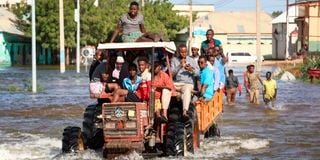In Somalia, climate change also makes political shifts difficult to predict

People ride on a tractor through floodwater in Beledweyne, central Somalia, on May 14, 2023.
What you need to know:
- These days, Somalia has been pummeled by the weather just as its politics have been habitually unpredictable.
- Scientists blame the erratic weather on climate change. And it could come as a burden for the policymakers.
On October 21, 1969, Somali military officers overthrew the post-colonial government, installing a dictatorship that eventually cost Somalia’s stability two decades later.
But those soldiers who acted in the coup were helped by a stable weather pattern. In Somalia, October and November used to experience short rains known locally as Dayr.
On that fateful morning, historians remember, Dayr rains helped to disguise the movement of the army vehicles and the operations of the armed men whose aim was to seize the top government officials before dawn. It worked perfectly.
“Perhaps, apart from good plans, they (the army officers) were partly successful because their activities were not noticed due to the rains,” Hussein Hassan, a local social commentator, told The EastAfrican in Mogadishu.
Somalia’s weather pattern was predictable then: Two rainy seasons on opposite sides of dry spells. The long rains known as Gu’ often started early in April to June. And Dayr followed before it was replaced by another dry spell earlier in the year.
These days, Somalia has been pummeled by the weather just as its politics have been habitually unpredictable. Scientists blame the erratic weather on climate change. And it could come as a burden for the policymakers of the country.
A report released this week by charity group Care warned that the number of people who will face acute food insecurity is projected to reach 4.4 million due to below-average rainfall and the looming La Niña phenomenon.
Care Somalia, a major humanitarian agency operating in the Horn of Africa country, indicated that millions are on the brink of starvation as hunger across Somalia intensifies. It referred to the latest Integrated Food Security Phase Classification (IPC) report.
Extreme climate-induced weather events, rising food prices, conflict, and inadequate funding for humanitarian aid, which have pushed the country towards a humanitarian disaster that could erode progress on gender equality for women and girls.
For families like that of Saynab, a mother of eight who was displaced from her home due to the drought, the hunger crisis is a harsh reality. After losing nearly all her livestock, Saynab and her family were forced to flee to a nearby village with only seven surviving animals.
“Women, the heart of their communities, are struggling to feed their families. Girls risk being pulled out of school to help at home or forced into early marriage,” said Ummy Dubow, Care Somalia Country Director.
“The worsening hunger crisis in Somalia will have devastating consequences for women and girls, who are often the first to suffer in times of extreme hardship.
“Women and girls must travel longer in search of food and water, which exposes them to dangers.”
“We used to have a good life when we had our animals,” Saynab explained. “Now, we have nothing. I have to collect firewood to sell in order to buy food for my family, and even then, we can only eat once a day.”
Saynab’s story is symbolic of the thousands of Somali families displaced by climate change and conflict, said Ummy Dubow.
Limited funding is severely hampering the ability of humanitarian agencies to provide life-saving interventions, including food, clean water, health services, and nutrition to affected communities.
“Every day, we witness the struggle that families, especially mothers, and children who come to our health centers, seeking care and support are experiencing due to the dry spell,” said Ali Nur, Director at Gargaar Relief and Development Organisation (Gredo), a Care partner.
Together, we are working to build healthier, stronger communities across Somalia but we need more support. We need to act now to save lives."
Somalia faces the prospect of another challenging rainy season, with forecasts of below-average rainfall (La Niña) through to March 2025 and above-normal temperatures.
On Wednesday, UN Office for the Coordination of Humanitarian Affairs (Ocha), stated that the humanitarian crisis in Somalia is dire with 6.9 million people, almost two in five Somalis, are in need of humanitarian assistance in 2024.
Somalis are still battling the lingering effects of the 2022 drought in decades and subsequent flooding in 2023 and 2024.
“The above-average rainfall totals of 2024 Gu’ season caused significant flooding in April to May, compounded by degraded topsoil following a prolonged drought.
Moreover, flooding destroyed shelter, schools, and critical water and sanitation infrastructure, a contributing factor to uninterrupted cholera/ acute watery diarrhea transmissions in various regions across the country,” Ocha underlined.
This Deyr (October-December) rainfalls, essential for food production, are anticipated to be below-average, linked to a 70 percent likelihood of La Niña conditions, which is likely to further drive needs for humanitarian assistance in 2025.
The Humanitarian Needs and Response Plan (HNRP), by the UN and its partners, requires $1.6 billion to meet the needs of 5.2 million people - a 37 percent reduction from $2.6 billion that was required to aid 7.6 million people in 2023.
A failure to assist now will lead to increasing numbers of people requiring assistance in the future, Ocha warns. It could still put pressure on politicians who may be accused of failing to deliver on their promises.





